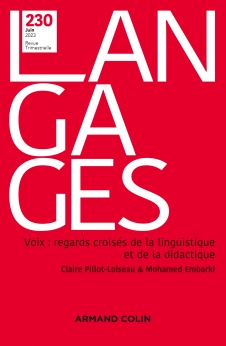
Langages N° 230 (2/2023)
Pour acheter ce numéro, contactez-nous
Recevez les numéros de l'année en cours et accédez à l'intégralité des articles en ligne.
The notion of voices of languages has not been established in language science so far, but it is empirically relevant for plurilingual speakers, expert ones (writers in multiple languages, singers, poetic performers) as well as foreign language learners. The goal of this study is to elaborate on the concept of language voice and envisages languages in the terms of energeia (embodied, embedded and mimetic interactivity) rather than ergon (structures). A language mobilizes and shapes the speaking bodies into a shared phonatory mode out of which emerges a common vocal characteristic conveying identity and fostering semiosis. This study elaborates on the voices of languages on the basis of research about articulatory modes and bases/settings and coarticulation, and sketches an extended and interactive conception of embodied phonation in a contrastive and enactive outlook relevant for language teaching.

